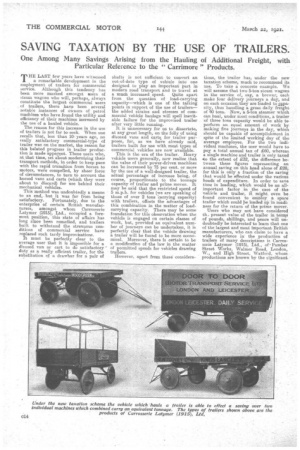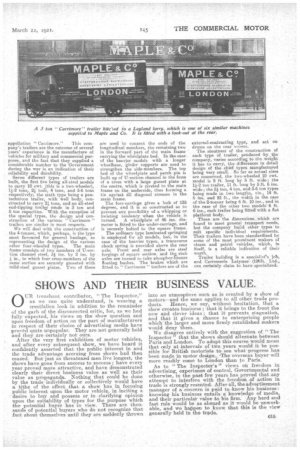SAVING TAXATION BY THE USE OF TRAILERS.
Page 18

Page 19

If you've noticed an error in this article please click here to report it so we can fix it.
One Among Many Savings Arising from the Hauling of Additional Freight, with Particular Reference to the " Carrimore " Products.
TFIE LAST few years have witnessed a remarkable development in the employment of trailers for commercial service. Although this tendency has been more marked amongst users of steam wagons who will, perhaps, always constitute the largest commercial users of trailers, there have been several notable instances of owners of petrol machines who have found the utility and efficiency of their machines increased by the use of a hauled vehicle.
The reason for this increase in the use of trailers is not far to seek. When one recalls that, less than 10, years ago, no really satisfactory commercial-type of trailer was on the market, the reason for this belated progress in trailer production is made apparent. Those users who, at, that time, set about modernizing their transport methods, in order to keep pace with the rapid transition from horses to motors, were compelled, by sheer force of circumstances, to turn to account the horsed vans and carts (which they were about to discard) for use behind their mechanical vehicles.
This method was undoubtedly a means to an end, but it was far from being satisfactory. Fortunately, due to the enterprise of certain British manufacturers, amongst whom Carrosserie Latymer (1915), Ltd., occupied a foremost position, this state of affairs has long since been remedied, and trailers built to withstand the strenuous conditions of commercial service have replaced such tardy improvisations.
It must be perfectly: clear to the average user that it is impossible for a disused van or cart to do satisfactory duty as a really efficient trailer, for the substitution of a drawbar for a pair of
shafts is not sufficient to convert an out-of-date type of vehicle into one designed to play an important part in modern road transport and to travel at a much increased speedQuite apart from the question of load-carrying capacity—which is one of the talking points in support of the use of trailers— the added strains and stresses of commercial vehicle haulage will spell inevitable failure for the improvised trailer after very little running. It is unnecessary for us to dissertate, at any great length, on the folly of using disused vans and carts for trailer purposes, for, as we have already said, trailers built for use with most types of commercial vehicles are now available.
This is the era of the trailer. Heavy vehicle users generally, now realize that the value of their power-driven machines can be increased by 75 per cent. or more by the use of a well-designed trailer, the actual percentage of increase being, of course, proportionate to the tonnage capacity of trailer and prime mover. It may be said that the restricted speed of 5 m.p.h. for vehicles (we are speaking of those of over 2 tons barrying capacity) with trailers, offsets the advantages of this combination in the matter of loadcarrying capacity. There may be some foundation for this observation when the vehicle is engaged on certain classes of work, but, provided an equivalent number of journeys can be undertaken, it is perfectly clear that the vehicle drawing a trailer will be found to be more economical. Moreover, there is certain to be a modification of the law in the matter of permitted speeds for vehicles drawing trailers.
However. apart from theseconsiders
lions, the trailer has, under the new taxation scheme, much to recommend its use. To take a concrete example. We will assume that two 5-ton steam wagons in the service of, say, a brewer, each make four delivery journeys a day, and on each occasion they are loaded to lapacity, thus handling a gross daily freight of 90 tons. Now, a 5-ton steamer which can haul, under most conditions, a trailer of three tons capacity would be able to perform an equal amount of work by making five journeys in the day, which should be capable of accomplishment in spite of the limited working day of the average employee. For the two individual machines, the user would have to pay a total annual tax of LK whereas a single machine and trailer is only taxed 4o the extent of £52, the difference between these figures representing an annual saving on this head alone of £28, for this is only a fraction of the saving that would be effected under the various heads of expenditure. In order to save time in loading, which would be an allimportant factor in the case of the vehicle and trailer, i might even be found convenient to employ a spare trailer which could be loaded up in readiness for the return of the prime mover. Users who may not have considered th_ present value of the trailer in terrns of ponnds, shillings, and pence will undoubtedly be interested to learn that one of the largest and most important British manufacturers, who can claim to have a wide experience in the production of trailers of many descriptions is Carrosaerie Latymer (1915), Ltd., of %Paml3er Street Works, Weimer Road, London, W., and High Street, Watford, whose productions are known by the significant, appellation " Carrimore." This com pany's trailers are the outcome of several years' experience in the manufacture of vehicles for military and commercial purposes, and the fact that they supplied a considerable number to the Government during the war is an indication of their
reliability and durability. Seven different types of trailers are built, the first five being ail-steel models to carry 10 cwt. (this is a two-wheeler), 11-2 tons, 21. torrs, 4 tons, and 5-6 tons respectively; the sixth type being a pantechnicon trailer, with well body, constructed to carq 2L tons, and an all-steel end-tipping trailer .made in 3 ton and 5 ton capacities. With the exception of the special types, the design and construction of the various " Carrimore " trailers are similar in most respects.
We will deal with the construction of the 4-tonner, which, perhaps, is the type most favoured for general haulage, as representing the design of the various
other four-wheeled types. The main frame consists of two members of U-seetion channel steel, 31 ins. by 2 ins. by A in., to which four cross-members of the .sanie section are securely gusseted with mild-steel gusset plates. Two of these
are used to connect the ends of the longitudinal members, the remaining two in the forward part of the main frame carrying the wheelplate bed. In the case of the heavier models with a longer wheelbase, girder supports are used to strengthen the side-members. The top bed of the wheelplate and perch pin is built up of T.J section channel in the form of a cross with a large gusset plate at the centre, which is riveted to the main frame on the underside, thus forming a tie against all diagonal stresses in the main frame.
The fore-earriage gives a lock of 135 degrees, and it is so constructed as to prevent any, possibility of a Whipping or twisting tendency when the vehicleis
turned. A wheelplate of 46 ins, diameter is fitted to the under-carriage, and is securely bolted to the square frame.
The ordinary type laminated springing is employed for all models, but, in the case of the heavier types, a transverse check spring is provided above the rear axle. Front and rear axles are steel forging% of square section. and the stub axles are turned to take phosphor-bronze floating bushes. The brakes which are fitted to " Carrimore " trailers are of the external-contracting type, and act on drums on the rear \meets.
The stoutness of the construction of each type of trailer, produced by the company, varies according to the weight it has to carry, the differences in detail design of the chief types manqfactured being very small. So far as 'actual sizes are concerned, the two-wheeled 10 cwt. model is 9 ft. long by 5 ft. wide ; the 1i-2 ton trailer, 11 ft. long by 5 ft. 6 ins. wide ; the 24ton, 4 ton, and 5-6 ton types being made in two lengths, viz., 14 ft. 6 ins. and 12 ft., the width in the case of the 2-tonner being 6 ft. 10 ins., and in the case of the other two models6 ft. 6 ins., each trailer being fitted with a flat platforni body.
These are the dimensions which are found to meet general transport needs, but the company build other types to suit specific individual requirements. Their trailers have been standardized by some of the most prominent makers of steam and petrol vehicles, which, in itself, is a reliable indication of their worth.
Trailer building is a specialist's job, and Carrosserie Latymer (1915). Ltd., can certainly claim to have specialized.
































